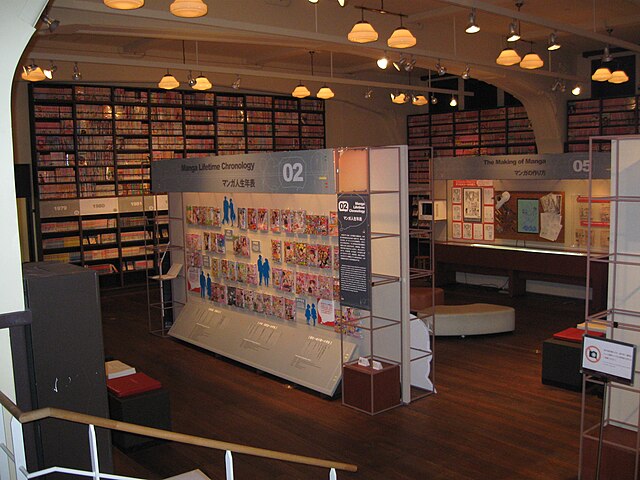Edit 7 October 2019: Updated prices to reflect the increase in Japan's national sales tax.
Over the past several decades, the art of Japanese comic books, known as manga (漫画, lit. 'cartoon pictures'), have become one of the country's most influential cultural exports. They have readers across all demographics and tell stories across many, many genres. In fact, most anime series on TV are based on a manga. And now, they finally have their own museum. The Kyoto International Manga Museum (京都国際マンガミュージアム, Kyōto Kokusai Manga Myūjiamu) was opened in 2006, in a former elementary school building in downtown Kyoto.
 |
| By Peat Bakke [CC BY 2.0], via Wikimedia Commons |
When the weather is nice, you can even take books out to the courtyard and read them outside! Just keep them within the admission gates, please.
Even better, on days off from school, you might see fans coming together and cosplaying their favourite characters! I don't know if this is a regular thing or not, but I sure lucked out in that regard during my first visit! My second time, not so much; it was a school day, after all.
 |
| By Kento Ikeda [CC BY 2.0], via Wikimedia Commons |
 |
| By Maplestrip [CC BY 3.0], from Wikimedia Commons |
One of the temporary exhibits was a showcase on the artist known as Yukiko Tani (谷ゆき子, Tani Yukiko, 1935-1999), who drew stories about ballet during the '60s and '70s. If that doesn't sound interesting, well, how may other stories about ballet, manga or otherwise, have the heroine training by meditating under a waterfall, or balancing en pointe on the edge of a cliff? I have to admit, I'm curious to see more! Surprisingly, there haven't been any stand-alone books made of her works -- that was, until October 2016, which is why this exhibit was set up.
 |
| By Kento Ikeda [CC BY 2.0], via Wikimedia Commons |
The cafe on-site serves a small menu of light meals. What's interesting about this place is the assortment of sketches drawn on the walls by manga artists. You know, I personally have dreams of making my own manga comic, but haven't quite had the drive to put my ideas into product. Maybe the prospect of having my own drawing represented here, be it ever so remote a chance, may inspire me to make my visions into reality...! Visit the Kyoto International Manga Museum yourself, and see what inspires you!
Hours: Open 10:00 AM to 6:00 PM. Admission ends 30 minutes before closing time. Closed on Mondays and New Year's Day.
Costs: ¥800.
Address: Karasuma-Oike, Nakagyō-ku, Kyōto-shi, Kyōto-fu 〒604-0846
Access: The museum stands above Karasuma-Oike Station, the junction of the Karasuma (K) and Tozai (T) subway lines. From Kyoto Station, take the Karasuma line to Karasuma-Oike (K08, 5 minutes, ¥220). The closest station exit is Exit 2.
Website: (English) (Japanese)
Access: The museum stands above Karasuma-Oike Station, the junction of the Karasuma (K) and Tozai (T) subway lines. From Kyoto Station, take the Karasuma line to Karasuma-Oike (K08, 5 minutes, ¥220). The closest station exit is Exit 2.
Website: (English) (Japanese)





